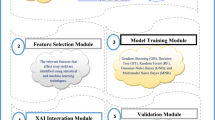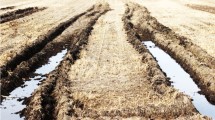Abstract
The aim of this paper is to provide a method that enables a farmer to: (i) decide whether or not the spatial variation of a field is suitable for a reliable variable-rate application, (ii) to determine if a particular threshold (field segmentation) based on the within-field data is technically feasible with respect to the equipment for application, and (iii) to produce an appropriate application map. Our method provides a Technical Opportunity index (TOi). The novelty of this approach is to process yield data (or other within-field sources of information) with a mathematical morphological filter based on erosions and dilations. This filter enables us to take into account how the machine operates in the field and especially the minimum area (kernel) within which it can operate reliably. Tests on theoretical fields obtained by a simulated annealing procedure and on a real vineyard showed that the TOi was appropriate for assessing whether the spatial variation in a field was technically manageable.







Similar content being viewed by others
References
Best, S., Leon, K., & Claret, M. (2005). Use of precision viticulture tools to optimize the harvest of high quality grapes. In Proceedings of the Fruits and Nuts and Vegetable Production Engineering TIC (Frutic05) Conference, Montpellier, pp. 249–258. On line on http://www.cemadoc.cemagref.fr/exl-doc/colloque/ART-00001647.pdf.
Bramley, R. G. V., & Lamb, D. W. (2003). Making sense of vineyard variability in Australia. In R. Ortega & C. Esser (Eds.), Proceedings of the International Symposium on Precision Viticulture, 9th Latin American Congress on Viticulture and Oenology, Santiago, Chile, pp. 35–54.
Bramley, R. G. V., & Hamilton, R. P. (2004). Understanding variability in winegrape production systems 1. Within vineyard variation in yield over several vintages. Australian Journal of Grape and Wine Research, 10, 32–45.
Bramley, R. G. V., Proffitt, A. P. B., Hinze, C. J., Pearse, B., & Hamilton, R. P. (2005). Generating benefits from precision viticulture through differential harvest. In Proceedings of 5th European Conference on Precision Agriculture, Uppsala, pp. 891–898.
Bullock, D. S., DeBoer, J. L., & Swinton, S. M. (2002). Adding value to spatially managed inputs by understanding site-specific yield response. Agricultural Economics, 27, 233–245.
De Oliveira, R. P., Whelan, B., McBratney, A., & Taylor, J. (2007). Yield variability as an index supporting management decisions: YIELDEX. In J. Stafford (Eds.), Precision Agriculture’07: Proceedings of the 6th European Conference on Precision Agriculture. Wageningen Academic Publishers, pp. 281–288.
Goovaerts, P. (1997). Geostatistics for natural resources evaluation. Applied geostatistics series. New York: Oxford University Press.
Korsaeth, A., & Riley, H. (2006). Estimation of economic and environmental potentials of variable rate versus uniform N fertilizer application to spring barley on morainic soils in SE Norway. Precision Agriculture, 7, 281–293.
Pringle, M. J., McBratney, A. B., Whelan, B. M., & Taylor, J. A. (2003). A preliminary approach to assessing the opportunity for site-specific crop management in a field, using yield monitor data. Agricultural Systems, 76, 273–292.
Rider, T. W., Vogel, J. W., Dille, J. A., Dhuyvetter, K. C., & Kastens, T. L. (2006). An economic evaluation of site-specific herbicide application. Precision Agriculture, 7, 379–392.
Roudier, P., Tisseyre, B., Poilve, H., & Roger, J. M. (2007). Management zone delineation base on remotely sensed data. In J. Stafford (Eds.), Precision Agriculture’07: Proceedings of the 6th European Conference on Precision Agriculture. Wageningen academic publishers, pp. 625–632.
Serra, J. (1982). Image analysis and mathematical morphology. London: Academic Press.
Taylor, J., Tisseyre, B., Bramley, R., & Reid, A. (2005). A comparison of the spatial variability of vineyard yield in European and Australian production systems. In J. Stafford & A. Werner (Eds.), Precision Agriculture’05: Proceedings of the 5th European Conference on Precision Agriculture. Wageningen Academic Publishers, pp. 907–915.
Tozer, P. R., & Isbister, B. J. (2007). Is it economically feasible to harvest by management zone? Precision Agriculture, 8, 151–159.
Tisseyre, B., Ojeda, H., & Taylor, J. (2007). New technologies and methodologies for site-specific viticulture. International Journal of Wine and Vine Research, 41, 63–76.
Tisseyre, B. (2003). La viticulture de précision, vers une connaissance très affinée des moyens de production. In Institut Rhodanien (Eds.), Actes des 7émes rencontres rhodaniennes, institut rhodanien, pp. 25–34.
Whelan, B. M., & McBratney, A. B. (2000). The “null hypothesis” of precision agriculture mangagement. Precision Agriculture, 2, 265–279.
Acknowledgments
This work forms part of the project VI-TIS, project Eureka, funded by the French Ministry for Research.
Author information
Authors and Affiliations
Corresponding author
Rights and permissions
About this article
Cite this article
Tisseyre, B., McBratney, A.B. A technical opportunity index based on mathematical morphology for site-specific management: an application to viticulture. Precision Agric 9, 101–113 (2008). https://doi.org/10.1007/s11119-008-9053-5
Published:
Issue Date:
DOI: https://doi.org/10.1007/s11119-008-9053-5




